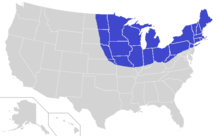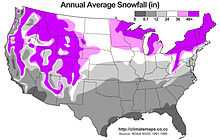Frost Belt


The Frost Belt is a region of the United States generally considered to include New England, the Great Lakes Region, and much of the Midwest. The region is known for its cold, frost-producing winters and heavy snowfall.
The Frost Belt was for many years the center of American economic activity, and the most populous part of the United States. A shift away from domestic manufacturing beginning in the 1980s dealt a heavy blow to the region's economy. For most of the latter 20th century, the Frost Belt had already been experiencing a stagnating population as Americans relocated to the more temperate Southern and Western regions of the country. This shift was caused by economic factors as well as social developments; the desegregation of the South and easing of racial tensions in that area made it a more welcoming place for African-Americans and other minorities. Even the advent of air conditioning played a role; the Southwest deserts, once almost uninhabitable for a part of the year, became a more viable alternative to the colder climates of the northern United States. Census results for the past several decades have indicated a population shift from the Frost Belt to the Sun Belt.[1] For various reasons many retirees decide to stay.[2]
See also
References
- ↑ Deering, Joseph A. (March 2004). "Janet Rothenberg Pack, Growth and Convergence in Metropolitan America". Journal of Sociology and Social Welfare. Retrieved 2011-02-28.
- ↑ Dirk Johnson (1999-02-06). "In the Frost Belt, a Place in the Sun". The New York Times. Retrieved 2009-02-08.
| ||||||